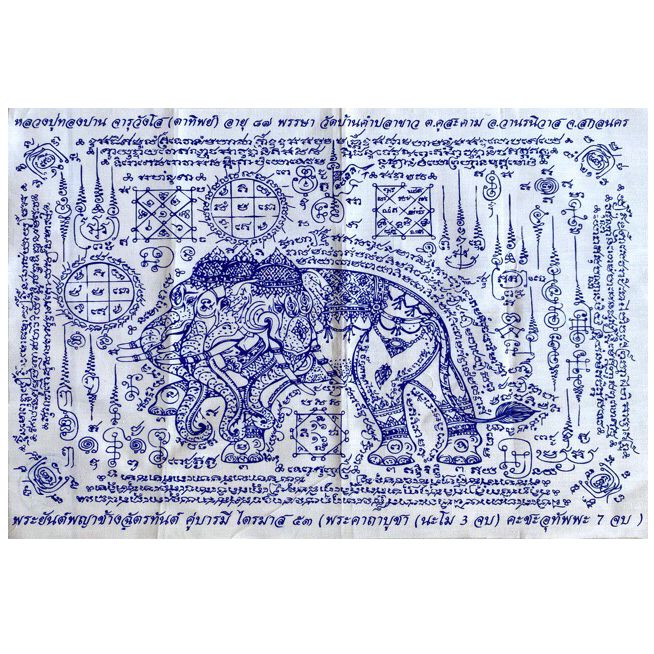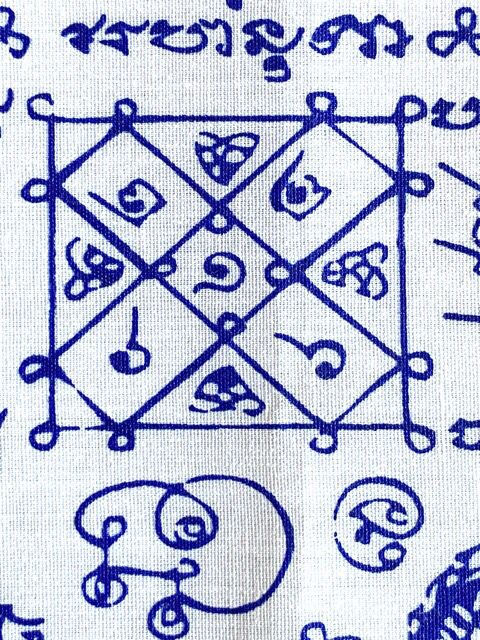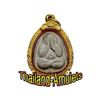

Thailand Amulets
Thai Buddhist and Magical amulets for Wealth, Health, Love and Happiness.
Vast Selection of Amulets
We have a vast selection of over 4000 different kinds of Sacred Amulets and Bucha Items, including Buddha Image, Loi Ongk statuettes, Buddhist Monk Coin Amulets, Takrut Charms, Nam Man Prai Oils, Mai Kroo Wands, Mitmor Ritual Knife, Lek Lai Kaya Siddhi Elemental Substance, Kumarn Tong, Gambling Amulets, Mae Nang Prai, Muan Sarn Sacred Powder Amulets, Palad Khik, Animist Charms, Necromantic Amulets, Buddhist, Animist, Brahman and Necromantic Amulets.
Pha Yant Paya Chang Chadtr Gant LP Tong Parn Wat Ban Kam Pla Khaw
The Sacred Pha Yant Paya Chang Chadtr Gant Yantra Cloth of the Elephant King with the Celestial Umbrella. Among the many ritual objects associated with the modern Thai Buddhist monastic tradition, the pha yant (sacred inscribed cloth) occupies a particularly luminal place between temple liturgy, talismanic practice, and popular devotion. The Pha Yant Phaya Chang Chatthan created under the authority of Luang Pu Thongpan (Thanajitto) of Wat Ban Kham Pla Khao has, in recent decades, become one of the most recognized and sought-after Pha Yant in the Northeastern (Isan) region of Thailand.
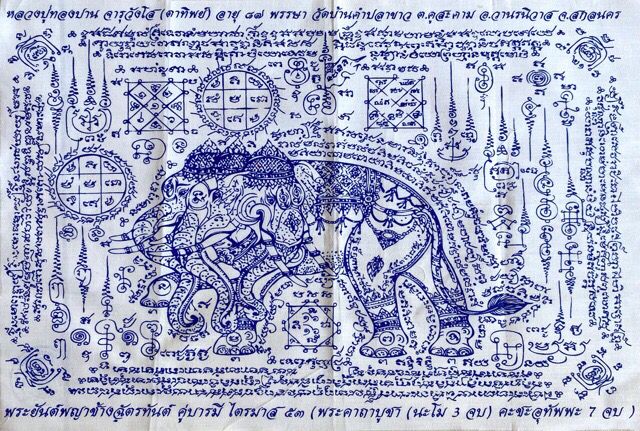
Its emergence reflects the interweaving of Buddhist consecration, animist cosmology, and the broader aesthetics of power and protection central to Thai popular religiosity. This item comes with two mp3 recordings, one for the Pha Yant Paya Chang Chadtra, and another for the Elephant Erawan story, as well as the The Elephant King's Sacred Cloth Fable Storybook (pdf) from Ajarn Spencer, which is a fable, made using AI generated imagery to support the story, and is a fantasy tale, designed to still be informative, as well as entertaining, to enjoy as 3 free extra digital downloads available after purchase.
1. Iconography and Function of the Elephant King Yant
The elephant has long held royal and cosmological significance in Southeast Asia. In this design, the “Elephant King” (Phaya Chang) is depicted beneath a chatra (celestial umbrella), the ancient Indic symbol of sovereignty, protection, and auspicious cosmic order. The elephant is both the vehicle of Indra (Airavata) in Hindu cosmology and the embodiment of power, stability, and fertility in local Thai and Lao traditions.
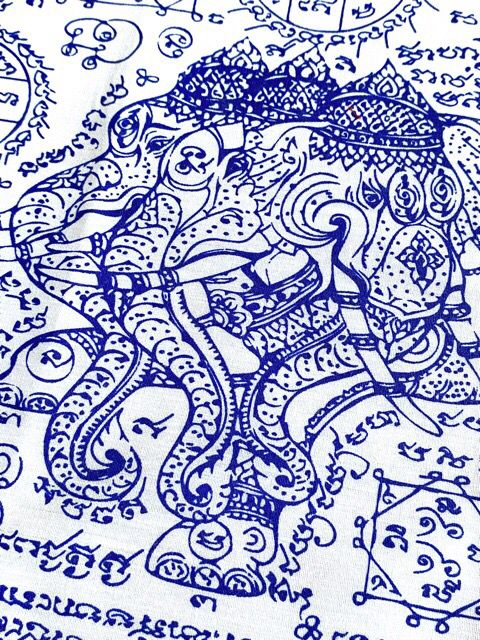
The Pha Yant Phaya Chang Chatthan thus serves several purposes at once:
- Protection for travelers and leaders: The elephant embodies steady passage and authority. Online marketplaces, temple publications, and collectors often emphasize its efficacy for individuals in positions of command, as well as for those frequently engaged in journeys.
- Authority and charisma (barami): The umbrella symbolizes accumulated spiritual merit and kingly protection. The combination marks the bearer as safeguarded by cosmic legitimacy.
- Apotropaic power: The inscribed yantra diagrams (yant) around the elephant form a protective mandala, channeling sacred syllables and incantations into visible form.
2. Editions and Production
The cloth has appeared in multiple editions and sizes. One common format is approximately 12×18 inches, a portable size suitable for enshrining in homes or vehicles. A more elaborate edition, known as the “Trimās 53 Khū Barami” (Rains Retreat 2010: Twin Powers Edition), measures roughly 45×31 cm and bears the official seal of the temple. Collectors note that this series was particularly emphasized for its ritual consecration and its association with Luang Pu Thongpan’s mid-period production of amulets.
The yantra cloths were not produced in isolation but as part of a broader ritual program of amulets (phra kring, coins, and protective cloths) designed to generate merit for the temple, provide material protection for devotees, and anchor the charisma of Luang Pu Thongpan in a tangible, transmissible medium.
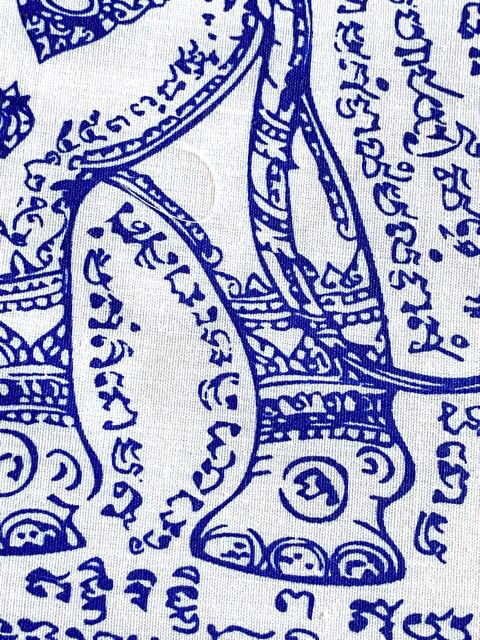
Ritual Consecration of the Pha Yant Phaya Chang Chatthan
The ritual consecration (phuttapisek and thewapisek) of the Pha Yant Phaya Chang Chatthan stands at the heart of its perceived potency. In Thai religious culture, the mere creation of a sacred design or object is never sufficient; its vitality derives from ritual activation, embedding it with spiritual resonance through both scriptural recitation and meditative empowerment.
1. Structure of the Ceremony
The consecration of the 2010 Trimās 53 Khu Barami edition followed the classic three-phase structure common to Isan and central Thai traditions:
- Preliminary purification (suddhi-kamma): The ritual space was prepared through chanting of protective paritta (e.g., Ratana Sutta, Metta Sutta). Water, flowers, and light offerings were arranged in concentric layers before the altar. The cloths were laid in an ordered stack, interspersed with yantra scrolls, metallic amulets, and ritual powders.
- Invocation of the devas (thewapisek): Monks invoked celestial guardians and local tutelary spirits (chao phum), aligning the consecration with the cosmic order. Chants such as the Itipiso and Jayanto were intoned rhythmically, while lay assistants circled incense to “call in” protective beings. The symbolism of the elephant—already a royal mount of Indra—made this phase particularly potent, for the cloth itself depicted a creature understood to be of divine origin.
- Central empowerment (phuttapisek): This was the ritual climax. Monks sat in a circle, holding consecration threads (sai sin) connecting them to the pile of sacred objects. Candles were lit in triangular formation to symbolize the Triple Gem. The collective chanting of the Khandha Paritta and Abhaya Paritta was carried out in low, resonant tones designed to “imprint vibration” into the cloth.
- Meditative empowerment (adhiṭṭhāna citta): Luang Pu Thongpan himself, seated at the head of the assembly, entered deep meditation. Witnesses from earlier ceremonies recall his practice of long, still samādhi, during which his breathing slowed almost imperceptibly. In Isan tradition, the master’s concentrated mind is the final seal, ensuring that each object bears the unique “signature” of his spiritual attainment (barami).
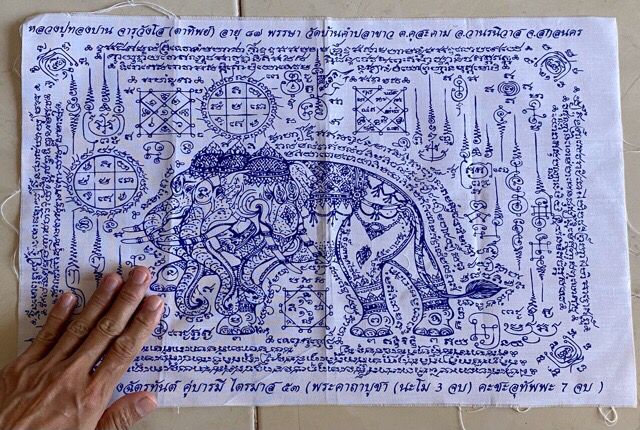
Participation of Revered Monks
Although temple archives do not provide a full roll call, informed collectors note that consecrations of this period often involved monks of regional and national prominence. Based on overlapping consecration rosters from proximate years, likely participants included:
- Luang Pu Koon Parisuttho (Wat Ban Rai, Nakhon Ratchasima) – One of the most iconic amulet-consecrating monks of late 20th-century Thailand. His reputation for invulnerability (kongkraphan) lent weight to any ceremony he attended.
- Luang Pu Thongphun Punnakamo (mentor of Luang Pu Thongpan) – A forest meditation master whose presence anchored the lineage legitimacy of the event.
- Luang Phor Chan (Wat Ban Kham Chanot) – Renowned for his mastery of yantra inscriptions and association with nāga cults.
- Regional Isan meditation masters who specialized in kammathān (forest asceticism), lending not celebrity but ascetic potency.
The very uncertainty surrounding exact attendance paradoxically enhances collector discourse: the possibility that great names sat in the circle imbues the cloths with an aura of extended charisma, an “imagined lineage” of blessings.
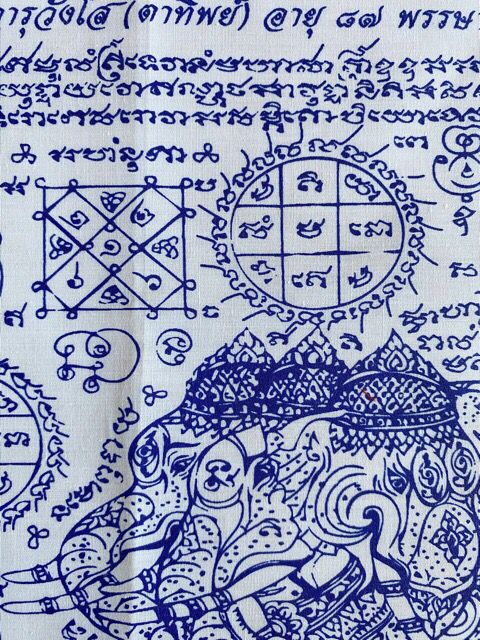
Liturgical Texts and Ritual Technologies
The consecration made use of specific ritual texts:
- The “Itipiso” triple chant (108 repetitions), symbolizing the Buddha’s qualities in full.
- The “Metta Mahaniyom” gāthā, associated with invincibility and attraction (metta mahaniyom).
- The “Phra Jao Sip Hok Phra Ong” invocation, a Northeastern liturgy that calls on the sixteen Buddhas of past eons for protection.
Other ritual technologies included:
- Sai Sin (white thread): forming a circle of protection, linking the monks’ psychic energy to the pile of cloths.
- Candles dripping wax: allowed to melt over the yantra, symbolizing the “sealing” of blessings.
- Holy powders (phong phutthakun): sprinkled during the final phase to embed mantra syllables in particulate form.
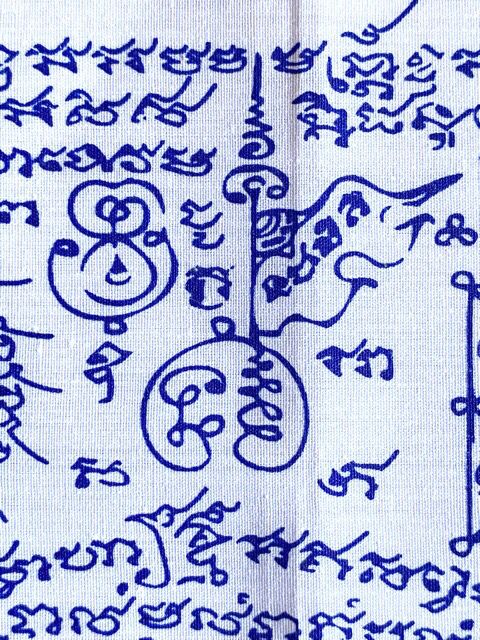
Cosmological Logic of Empowerment
To an outsider, these procedures may appear decorative; to the devotee, they embody a coherent cosmological logic:
- The yantra design is the map.
- The chants are the vibration that awakens it.
- The meditative mind of the master is the electrical current that animates the structure.
- The presence of multiple monks ensures redundancy, as if many circuits were wired in parallel.
Thus, the finished pha yant is not merely cloth, but a charged spiritual device, comparable in some respects to the Tibetan tsa tsa or Japanese ofuda.
Implications for Collectors
For collectors at Tha Phrachan, the authority of a pha yant depends less on its artistic flourish and more on ritual pedigree. The Trimās 53 edition has become especially desirable because:
- It is linked to a formally documented rains retreat.
- It was empowered in both private ascetic meditation and public liturgical ceremony.
- It is rumored to have had the participation (direct or indirect) of highly venerated national figures.
This creates a dual market value: ritual authenticity for the devotee, and pedigree authenticity for the collector-investor.
Biography of Luang Pu Thongpan (Thanajitto)
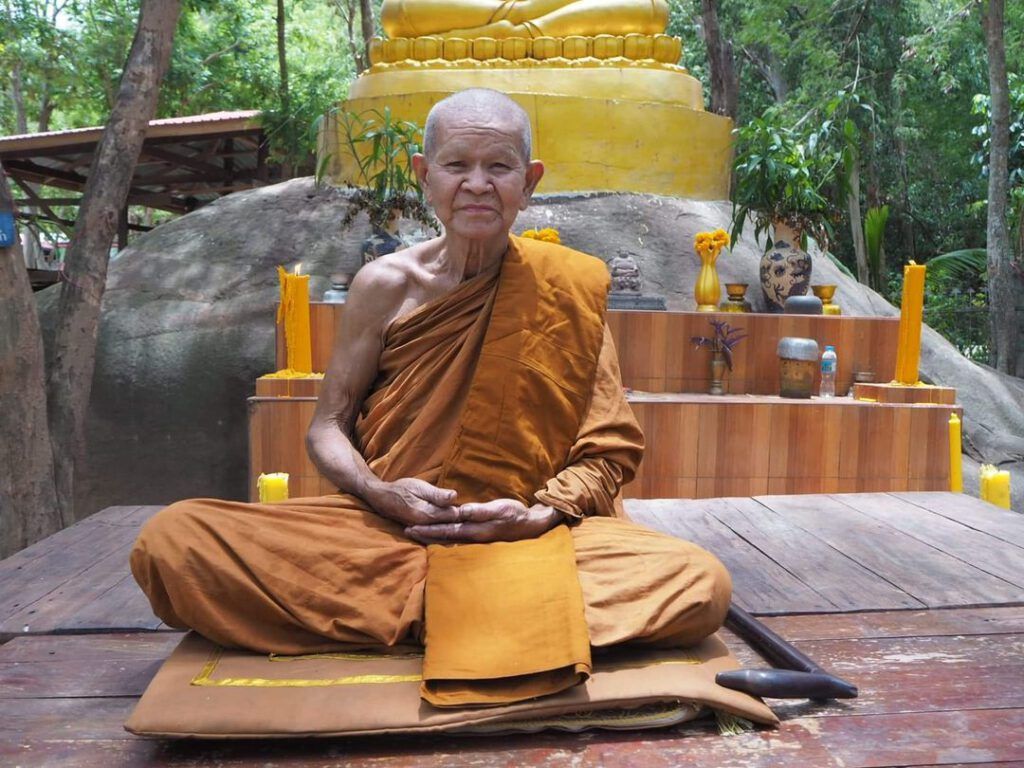
Luang Pu Thongpan, born 7 July 1945 in Khon Kaen Province, exemplifies the path of the Isan forest monk. Initially ordained briefly in youth, he returned to monastic life in 1990 at Wat Pa Aphaiwan, under the ordination of Phra Ratchawanawat. His most significant mentor was Luang Pu Thongphun Punnakamo, a highly respected forest meditation master.
Luang Pu Thongphun directed him to reside at Wat Pa Phupachan, Pak Thong Chai District, Nakhon Ratchasima—then a neglected hermitage in the hills. There, Thongpan established himself as the abbot, cultivating a reputation for ascetic rigor: dwelling in the open without mosquito nets, emphasizing solitary meditation, and transmitting concise but profound teachings.
His sermons emphasize forgiveness, impermanence, and the primacy of mental intention over material offering. One of his widely cited aphorisms contrasts the difference between anger that fades naturally and anger that dissolves through forgiveness, stressing that the latter elevates the heart to a higher state.
By his seventy-fifth year, he had become a figure of veneration across Korat (Nakhon Ratchasima) and Isan, regarded as a living embodiment of the forest tradition and a guardian of both spiritual and ritual power.
Wat Ban Kham Pla Khao: The Temple Context
The temple named Wat Ban Kham Pla Khao, associated with the release of the Elephant King pha yant, remains a local monastic institution in the Isan region. While detailed historical records of its founding remain elusive, the temple has emerged in recent decades as a focal point for amulet production and local devotion. Its role is less as a grand pilgrimage center and more as a community-based spiritual anchor, where ritual practices blend seamlessly with local beliefs in guardian spirits, Buddhist consecration, and protective magic.
For serious collectors, the temple’s authenticity lies precisely in this regional embeddedness: amulets and cloths issued from rural Isan temples carry the aura of unbroken forest tradition, in contrast to mass-produced objects from urban monasteries.
The Collector’s Perspective: Authority, Charisma, and Legitimacy
From the standpoint of the Bangkok amulet market—particularly the renowned Tha Phrachan quarter—the Pha Yant Phaya Chang Chatthan occupies an interesting middle ground. It is not merely decorative cloth, nor does it carry the heavy numismatic prestige of early Rattanakosin coins or Somdej amulets. Instead, it exemplifies the living ritual charisma of a provincial master, but as is said 'new amulets one day become ancient, and all ancient amulets, were once new'. meaning, that the Tha Prachan always keep their eyes on the present, knowing that one day, it will become the ancient past, and the status of the amulets will change, with the era they belong to.
Collectors emphasize:
- Authenticity of consecration: The fact that Luang Pu Thongpan directly empowered these objects.
- Symbolic completeness: The Elephant King with Celestial Umbrella combines two of the strongest auspicious motifs in Thai cosmology.
- Edition clarity: The Trimās 53 edition, with temple seal, allows secure provenance.
In this sense, the object embodies what Pierre Bourdieu might call “symbolic capital”—the intersection of ritual efficacy, social recognition, and aesthetic authority.
The Pha Yant Phaya Chang Chatthan of Luang Pu Thongpan ris of course, more than just a Buddhist talisman. It is the crystallization of multiple traditions: Indic elephant symbolism, Isan forest monastic charisma, ritual consecration practices, and the dynamics of Thailand’s modern amulet economy. For the scholar, it illustrates how local temples sustain and adapt protective traditions; for the devotee, it offers lived assurance of safety, authority, and blessing; and for the collector, it stands as a material testimony to the ongoing vitality of Thai ritual art.
Contact Us
Follow Us on Youtube
About Us
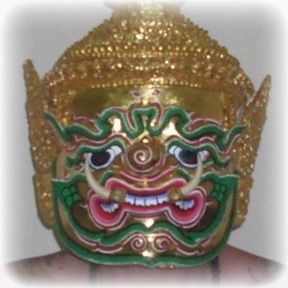
Ajarn Spencer
Proprietor
Thailand Amulets is owned and Administrated by Thai Occult and Amulet expert, Ajarn Spencer Littlewood who guarantees only authentic blessed amulets, and a free gift with every order, as well as his safe delivery or money back guarantee. https://facebook.com/ajarnspencer
